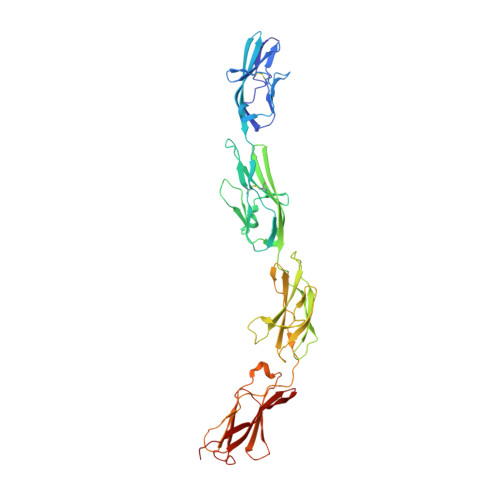Structural Basis for Interactions Between Contactin Family Members and Protein-tyrosine Phosphatase Receptor Type G in Neural Tissues.
Nikolaienko, R.M., Hammel, M., Dubreuil, V., Zalmai, R., Hall, D.R., Mehzabeen, N., Karuppan, S.J., Harroch, S., Stella, S.L., Bouyain, S.(2016) J Biol Chem 291: 21335-21349
- PubMed: 27539848
- DOI: https://doi.org/10.1074/jbc.M116.742163
- Primary Citation of Related Structures:
5E4I, 5E4Q, 5E4S, 5E52, 5E53, 5E55, 5E5R, 5E5U, 5E7L, 5I99 - PubMed Abstract:
Protein-tyrosine phosphatase receptor type G (RPTPγ/PTPRG) interacts in vitro with contactin-3-6 (CNTN3-6), a group of glycophosphatidylinositol-anchored cell adhesion molecules involved in the wiring of the nervous system. In addition to PTPRG, CNTNs associate with multiple transmembrane proteins and signal inside the cell via cis-binding partners to alleviate the absence of an intracellular region. Here, we use comprehensive biochemical and structural analyses to demonstrate that PTPRG·CNTN3-6 complexes share similar binding affinities and a conserved arrangement. Furthermore, as a first step to identifying PTPRG·CNTN complexes in vivo, we found that PTPRG and CNTN3 associate in the outer segments of mouse rod photoreceptor cells. In particular, PTPRG and CNTN3 form cis-complexes at the surface of photoreceptors yet interact in trans when expressed on the surfaces of apposing cells. Further structural analyses suggest that all CNTN ectodomains adopt a bent conformation and might lie parallel to the cell surface to accommodate these cis and trans binding modes. Taken together, these studies identify a PTPRG·CNTN complex in vivo and provide novel insights into PTPRG- and CNTN-mediated signaling.
Organizational Affiliation:
From the Division of Molecular Biology and Biochemistry, School of Biological Sciences, University of Missouri-Kansas City, Kansas City, Missouri 64110.















